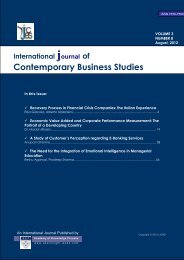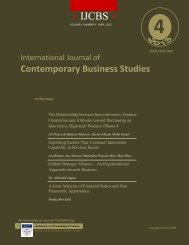Contemporary Business Studies - Academy of Knowledge Process ...
Contemporary Business Studies - Academy of Knowledge Process ...
Contemporary Business Studies - Academy of Knowledge Process ...
You also want an ePaper? Increase the reach of your titles
YUMPU automatically turns print PDFs into web optimized ePapers that Google loves.
International Journal <strong>of</strong> <strong>Contemporary</strong> <strong>Business</strong> <strong>Studies</strong>Vol: 4, No: 2. February, 2013 ISSN 2156-7506Available online at http://www.akpinsight.webs.comhypothesized national culture dimension as a moderator between international diversification strategy andperformance .One basis <strong>of</strong> this notion a model is developed to divide world into diversification region.International diversification strategyInternational Diversification strategy has negative relations with financial performance has been proved inMeta analysis. (Capon, Farley and Hoenig, 1990) While discussing several advantages whichInternational diversification <strong>of</strong>fers to firms? Buhner (1987) argue that international diversificationprovides future market opportunities, which gives firms the chance for greater expansion. The mostacknowledged argument for international diversification has been stranded on the hypothetical statementthat firms utilize the benefits <strong>of</strong> internalization in international markets (Hymer, 1976; Rugman, 1981;Caves, 1982).The benefits <strong>of</strong> economies <strong>of</strong> scale, economies <strong>of</strong> scope and learning can be achieved via internationaldiversification strategy and from international markets.(Kogut, 1985; Ghoshal, 1987; Kim et al., 1989,1993), and also allocation <strong>of</strong> core competencies between diverse business segments and geographicmarkets (Hamel, 1991).The complexity <strong>of</strong> firm’s operations is based on the experience <strong>of</strong> firm ininternational diversification (Zeithaml et al., 1985; Patterson and Cicic, 1995). Rugman (1981) found thatfirms with more international diversification experience have less diversification costs than firms withless diversification experience. Also targeting the national culture firms should mould the managementsystems in response to the local environment (Ghoshal, 1987).Performance“<strong>Business</strong> firms are compared in terms <strong>of</strong> pr<strong>of</strong>its, sales, market share, productivity, debt ratios, and stockprices. Hospitals use cost recovery, mortality and morbidity rates, board certification <strong>of</strong> physicians, andoccupancy rates. Universities use research productivity and prestige <strong>of</strong> faculties, test scores <strong>of</strong> students,rankings by popular magazines, and win/loss records <strong>of</strong> football teams.”(March and Sutton, 1997.p. 698)International Diversification strategy has negative relations with financial performance has been proved inMeta analysis. (Capon, Farley and Hoeing, 1990)Pothukuchi et al. (2002, p. 258) originate that the accepted negative effect from partner difference on IJVperformance originates more from differences in organizational culture than from differences in nationalculture While in some cases increased national differences can lead to higher performance <strong>of</strong> internationalalliance partners. (Morosini et al., 1998). Another area <strong>of</strong> research has discussed a nonlinear relationshipbetween multinationality and performance, and has argued for a hypothetical foundation for justification<strong>of</strong> their position (Tallman and Li, 1996; Hitt et al., 1997; Gomes and Ramaswamy, 1999; Kotabe et al.,2002).Criticizing this concept, Dess et al. (1995) argue that geographic scope is not relevant to performance;rather, it is the ownership <strong>of</strong> proprietary assets—which is the momentum to foreign direct investment andthat is the final source <strong>of</strong> higher firm performance. Montgomery (1985) and Christensen and Montgomery(1981) establish confirmation that performance differences between diversified firms were attributable inpart to differences in market structure between the industries in which the firm competed.International Diversification Strategy and PerformanceThe relationship between international diversification and firm performance has been an important topicfor researchers in strategic management and international business (Buhner, 1987; Grant, 1987; Danielsand Bracker, 1989; Geringer et al., 1989; Haar, 1989; Tallman and Li, 1996; Hitt et al., 1997; Delios andBeamish, 1999; Gomes and Ramaswamy, 1999; Geringer et al., 2000; Kotabe et al., 2002). Thisimportance <strong>of</strong> international diversification is due to representation <strong>of</strong> a growth strategy (Chandler, 1962;Ans<strong>of</strong>f, 1965) that has most important prospective impact on firm performance.2013©<strong>Academy</strong> <strong>of</strong> <strong>Knowledge</strong> <strong>Process</strong>88
















